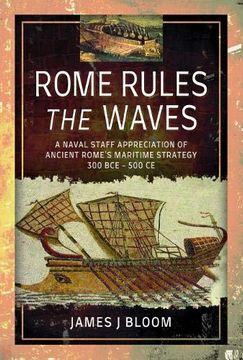Compartir
Rome Rules the Waves: A Naval Staff Appreciation of Ancient Rome's Maritime Strategy 300 Bce - 500 Ce (en Inglés)
James Bloom
(Autor)
·
Pen & Sword Military
· Tapa Dura
Rome Rules the Waves: A Naval Staff Appreciation of Ancient Rome's Maritime Strategy 300 Bce - 500 Ce (en Inglés) - Bloom, James
$ 118.380
$ 236.761
Ahorras: $ 118.380
Elige la lista en la que quieres agregar tu producto o crea una nueva lista
✓ Producto agregado correctamente a la lista de deseos.
Ir a Mis Listas
Origen: Estados Unidos
(Costos de importación incluídos en el precio)
Se enviará desde nuestra bodega entre el
Miércoles 03 de Julio y el
Viernes 12 de Julio.
Lo recibirás en cualquier lugar de Colombia entre 1 y 5 días hábiles luego del envío.
Reseña del libro "Rome Rules the Waves: A Naval Staff Appreciation of Ancient Rome's Maritime Strategy 300 Bce - 500 Ce (en Inglés)"
The commonly-held view of Rome's naval history is that it essentially ended with the defeat of Antony and Cleopatra's fleet at Actium in 31 BC, which left Rome with no rivals at sea just as the Republican period gave way to the Empire. There were no more big naval battles so, this view would have it, Rome's navy was scarcely needed and its role was of little significance to the strategy of the Empire. James J. Bloom rams this point of view below the waterline in his appraisal of the crucial role of both the Roman imperial navy and the steep learning curve of its predecessor, the naval forces of the Roman Republic. The author (following the line of preeminent naval theoreticians, Alfred Mahan and Sir Julian Corbett) takes the view that sea power is not merely about naval engagements. In its deeper sense, sea power is the steadfast exertion of command of the sea lanes to project trade, suppress piracy, transport troops and supplies and protect land-based military garrisons and expeditions. In effect, this book is a grand-strategical survey of Roman naval power as an instrument to support Roman imperial policy. In contrast to other works on the subject, Bloom argues that modern naval strategic theory can be usefully applied to Roman naval operations.The geography of their empire determined that the Romans would move most of their military supplies by water. During both the Republican and Imperial periods, nearly all of the provinces had extensive coasts alongside the Mediterranean, the Black Sea or the Atlantic Ocean. These interconnected seaways gave the Romans a distinct advantage over their adversaries around the perimeter, who generally had to utilize coasts adjacent to or interdicted by Roman maritime control. As Roman land power threaded along the Black Sea and Atlantic shorelines, major river and estuarine systems became a significant component of this web of vital waterways. Amphibious reach was an essential element of Roman sea power in guarding the wet flanks of the legions and ferrying troops to threatened choke points. Appendices will include scale drawings of the various ship types discussed in the text with their characteristics displayed in tabular form, several maps illustrating the maritime factors of the empire, and a resume of maritime exploration and discoveries in Roman times.
- 0% (0)
- 0% (0)
- 0% (0)
- 0% (0)
- 0% (0)
Todos los libros de nuestro catálogo son Originales.
El libro está escrito en Inglés.
La encuadernación de esta edición es Tapa Dura.
✓ Producto agregado correctamente al carro, Ir a Pagar.

